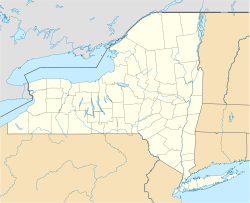- Livingston Avenue Bridge
-
Livingston Avenue Bridge
A tour boat heading north passes through the Livingston Avenue BridgeOther name(s) North Bridge or Hudson River Bridge Carries CSX and Amtrak trains Crosses Hudson River Locale Albany and Rensselaer, NY Maintained by CSX Design Swing bridge Opened 1901 Coordinates 42°39′16″N 73°44′30″W / 42.65431°N 73.741777°WCoordinates: 42°39′16″N 73°44′30″W / 42.65431°N 73.741777°W The Livingston Avenue Bridge is a railroad bridge over the Hudson River in New York connecting Albany and Rensselaer. The original structure was built in 1866 by the Hudson River Bridge Company but was replaced in 1901. A rotating swing bridge, it still operates to allow large ships to proceed up the Hudson River. It is owned by CSX, and in addition to freight use it is used by Amtrak for east-west travel in New York. The cost to replace the bridge was estimated at $50 million in 1998.[1] The bridge also hosts an active railroad interlocking tower and the block operator on duty is responsible for directing rail traffic around Amtrak's Rensselaer terminal as well as opening and closing the bridge.
Contents
History
The Hudson River Bridge Company was incorporated April 9, 1856. Work on the bridge was begun in April 1864. The earlier Green Island Bridge had opened to the north in Troy in 1835, but required the longer route of the Schenectady and Troy Railroad west from Troy. The new bridge, called the Hudson River Bridge, was to connect directly to the New York Central Railroad on the west (Albany) side of the bridge and to the Hudson River Railroad, Troy and Greenbush Railroad and Boston and Albany Railroad on the east (Rensselaer) side. The turntable bridge was 4800 feet (1500 m) long, with a clearance of 30 feet (9 m) from high water when closed.
The first engine, the Augustus Schell, passed over the bridge on February 18, 1866. Passenger trains started using it on February 22. After the Maiden Lane Bridge was constructed a bit further south, the Hudson River Bridge was used mostly for freight trains and the few passenger trains that passed by Albany but did not need to stop there. The Maiden Lane Bridge was often referred to as the "South Bridge" and the Hudson River Bridge as the "North Bridge". In the winter of 1866, once travel patterns were set, Cornelius Vanderbilt, owner of the Hudson River Railroad, suddenly refused to allow any transfers from the New York Central. The New York Central board gave in, and in 1867 Vanderbilt acquired the company, and in 1869 merged it with the Hudson River Railroad to form the New York Central and Hudson River Railroad. This gave the New York Central a majority of ownership in the company; in 1900 the New York Central leased the Boston and Albany.
The current bridge was constructed in 1901 and was named the Livingston Avenue Bridge. At the time the original Hudson River Bridge was constructed Livingston Avenue had been named Lumber Street for it led to the Albany Lumber District.
A project is currently underway to rehabilitate the structure. One matter of contention is whether the project will restore the closed public walkway over the bridge. Doing so would greatly improve pedestrian access between Albany and Rensselaer, but the bridge owner, CSX, is citing safety concerns. [2]
See also
Sources
- The Albany Railroad Bridge, Harper's Weekly 1866
- The Bridge at Albany, New York Times February 24, 1866, page 1
References
- ^ Rehabilitation Project Information
- ^ "6) Livingston Avenue Bridge Rehabilitation and Waterfront Master Planning". Capital District Transportation Committee. http://www.cdtcmpo.org/revest/livingston.htm. Retrieved 9/23/2011.
External links
Crossings of the Hudson River Upstream
Patroon Island Bridge

Livingston Avenue Bridge Downstream
Maiden Lane Bridge
(demolished)Categories:- Bridges over the Hudson River
- Railroad bridges in New York
- New York Central Railroad bridges and tunnels
- Boston and Albany Railroad bridges and tunnels
- Buildings and structures in Albany, New York
- CSX Transportation bridges and tunnels
- Bridges completed in 1866
- Bridges completed in 1901
- Swing bridges in the United States
- Transportation in Albany, New York
Wikimedia Foundation. 2010.



